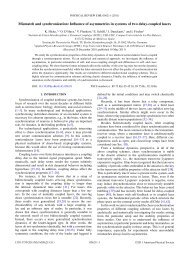DBI Analysis of Open String Bound States on Non-compact D-branes
DBI Analysis of Open String Bound States on Non-compact D-branes
DBI Analysis of Open String Bound States on Non-compact D-branes
Create successful ePaper yourself
Turn your PDF publications into a flip-book with our unique Google optimized e-Paper software.
CHAPTER 5. BRANES 68The presence <str<strong>on</strong>g>of</str<strong>on</strong>g> a Maxwell field <strong>on</strong> the D-brane has a very important c<strong>on</strong>sequence.C<strong>on</strong>sider the countour integral ∮⃗E · d ⃗ l. (5.29)CWhen we c<strong>on</strong>sider the electric field to be static, and this c<strong>on</strong>tour to be lying somewhere inordinary space, we can invoke Stokes’ theorem in combinati<strong>on</strong> with the (static) Maxwellequati<strong>on</strong> ∇ × ⃗ E = 0 to obtain∮C∫⃗E · d ⃗ l =S(∇ × E ⃗ )d⃗a = 0. (5.30)When c<strong>on</strong>sidering <strong>compact</strong> dimensi<strong>on</strong>s, something fundamental changes, namely thec<strong>on</strong>tour no l<strong>on</strong>ger bounds a surface since there is no “inner space” anymore. As ac<strong>on</strong>sequence, Eq. 5.29 can take <strong>on</strong> n<strong>on</strong>-zero values. Generalizing to the case <str<strong>on</strong>g>of</str<strong>on</strong>g> a vectorpotential A µ , and c<strong>on</strong>sidering its comp<strong>on</strong>ent al<strong>on</strong>g the <strong>compact</strong> dimensi<strong>on</strong> (say x 25 ),defineW q = e iq H c dx25 A 25. (5.31)This quantity is called a Wils<strong>on</strong> line, and it takes <strong>on</strong> a c<strong>on</strong>stant value in the <strong>compact</strong>interval [0, 2π]. Now we can c<strong>on</strong>sider a setup with several parallel Dp-<strong>branes</strong>, say N<str<strong>on</strong>g>of</str<strong>on</strong>g> them. We can thus c<strong>on</strong>sider several different open string c<strong>on</strong>figurati<strong>on</strong>s, in generaldefined by two labels i and j, respectively labeling the Dp-brane <strong>on</strong> which the stringstarts (σ = 0) and ends (σ = π). Now, suppose <strong>on</strong>e directi<strong>on</strong> is <strong>compact</strong>ified, andthat our Dp-<strong>branes</strong> wrap around this directi<strong>on</strong>. Due to the Maxwell field living <strong>on</strong> theD-<strong>branes</strong>, they will acquire a Wils<strong>on</strong> line θ i al<strong>on</strong>g the <strong>compact</strong> dimensi<strong>on</strong>. Amazinglyenough, when we take the T-dual <str<strong>on</strong>g>of</str<strong>on</strong>g> this <strong>compact</strong> dimensi<strong>on</strong>, the resulting D(p − 1)-<strong>branes</strong> will positi<strong>on</strong> themselves <strong>on</strong> the dual circle at angles θ i . This means that anopen string lying <strong>on</strong> <strong>branes</strong> i and j in the original descripti<strong>on</strong> will stretch <strong>on</strong> the dualcircle between angles θ i and θ j . The labels i, j are called “Chan-Pat<strong>on</strong> charges.” Thismechanism introduces gauge groups as follows: k coincident <strong>branes</strong> give rise to a U(k)group, while l seperate <strong>branes</strong> make for a U(1) l group.5.1.2 D-<strong>branes</strong> in Type IIA and Type IIB theoriesRecall the coupling <str<strong>on</strong>g>of</str<strong>on</strong>g> the string to the Kalb-Ram<strong>on</strong>d field shown in Eq. 4.16,S B = − 1 ∫4πα ′ d 2 σǫ αβ B µν (X) ∂ α X µ ∂ β X ν .This is in fact a generalizati<strong>on</strong> <str<strong>on</strong>g>of</str<strong>on</strong>g> the coupling <str<strong>on</strong>g>of</str<strong>on</strong>g> a vector field to a gauge field,∫dx µS A = q dτA µdτ , (5.32)where q represents the coupling c<strong>on</strong>stant to this field (e.g. electric charge). This generalizati<strong>on</strong>implies that a string couples electrically to the Kalb-Ram<strong>on</strong>d field.
















